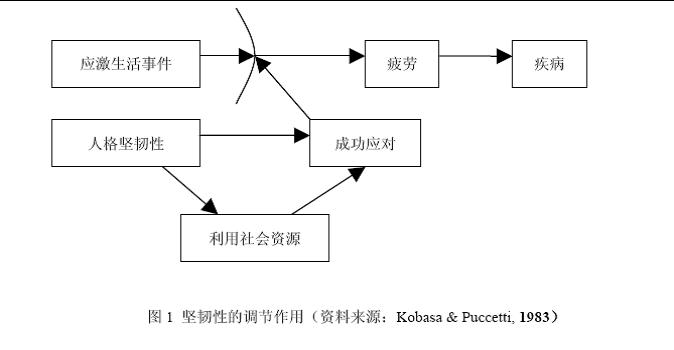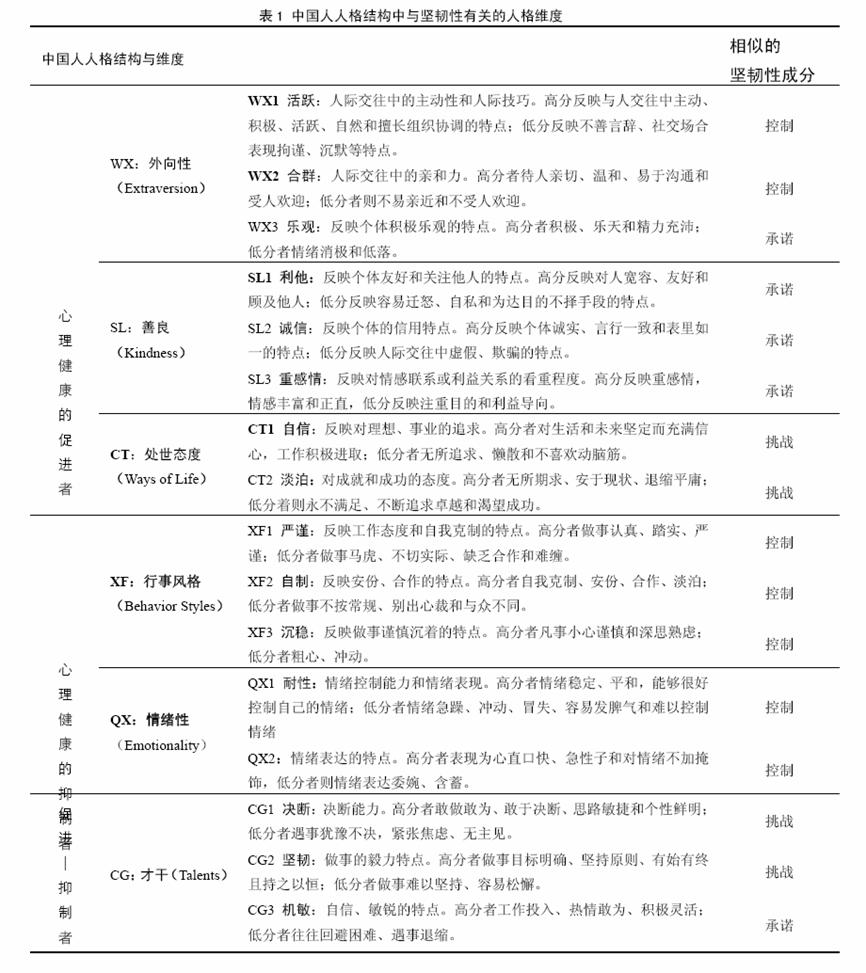邹智敏 王登峰
(北京大学心理学系暨人格与社会心理学研究中心,北京 100871)
摘 要 过去30年来,关注身心保健和组织行为的心理学家都对人格心理学中的一个概念发生了兴趣,就是人格坚韧性(hardiness),大量实证研究证明人格坚韧性可以有效地缓解生活应激给人们带来的身心不适,并有助于提高人们在各领域的工作表现。该文在回顾西方以往研究的基础上,介绍这一概念,以及这方面研究的不足之处,并提出在中国开展此项研究的思路。作为整体人格结构的一部分,人格坚韧性应该从人格“大五”或“大七”结构中探索。在中国已有研究发现,人格“大七”维度对身心健康有不同的影响,哪些维度构成人格坚韧性,这些问题有待进一步的研究。
关键词 坚韧性,人格,健康,应激。
分类号 B848
1 人格坚韧性概念的提出
应激(stress),也是我们通常所说的压力,是指个体在面对具有威胁性刺激情境中,一时无法消除威胁逃离困境时的一种被压迫的感受[1]。尽管许多调查者发现应激与疾病之间存在关联[2,3],但也不是每个人经历应激事件后都会患病。在应激与疾病之间存在许多中间调节变量[4]。其中有人格特点,社会支持,先天体质,情境因素和应对技巧[5]。而近些年心理学家更为关注的是人们应对潜在应激事件反应上存在的个体差异[6]。无论健康学还是组织管理中都在考察人格在应激与健康或工作绩效中间所起的中介作用。这些人格变量被看成是人们能够摆脱压力的有效资源。而坚韧性就是其中研究最多的一种人格资源[6]。
Kobasa及其同事整合了以往众多存在心理学家的理论,包括White提出的“胜任”(competence),Allport提出的“奋斗”(propriate striving),以及Fromm提出的“效果指向”(productive orientation),提出人格坚韧性(hardiness)的概念,用于解释为什么有些人可以顺利地渡过应激事件,而另一些人则不行[4]。她认为坚韧性是人格中用以抵制应激的一个结构,拥有这一簇人格特质的个体可以在高度的生活应激情境下免于应激的伤害[4,7,8]。
Kobasa提出坚韧性由3个相互关联的成分构成:承诺(commitment)、控制(control)和挑战(challenge),后来的学者也称之为坚韧性的“3C”结构。承诺,是指个体对于生活目的和意义的感知;控制,指相信命运掌握在每个人的手里,个体能通过自身的努力来改变生活;挑战,指个体认为变化才是生活的常态、是个体成长的动力。
因此,坚韧性强的个体好奇心强,总能在自己的经历中发现乐趣和意义(承诺)。而且,他们相信他们的所想、所言、所为有一定的影响力(控制)。同时,他们期盼日常生活有所变化,认为变化是发展的重要动力(挑战)。这些信念和倾向对于个体应对应激事件来说非常有用。变动,哪怕让他们感觉有压力,同样被看成是很自然、有意义、甚至有趣的事情。并且,他们会立刻做出相应的果断行动,来了解新情况,将它们纳入原定计划中,并从中吸取对将来有用的经验。通过这些方式,坚韧性强的人降低了对应激性事件的压力感。相反,坚韧性差的个体,总是感到自己和周围环境都没什么意思、没有意义,甚至很危险。他们对迎面而来的难题感到无力解决,认为生活最好不发生什么改变。当应激事件发生后,由于他们的人格无法提供或提供很少的缓和作用,因此应激事件便可能损害他们的身心健康[5]。
例如,面临失业,坚韧性强的人会采取行动积极寻找另一份工作(控制),还会到同行或主管那里调查自己为什么会被辞退(承诺),同时,他/她还会想到这可能是重新计划职业发展的一个机会(挑战)。但面对同样一件事,坚韧性差的人就会手足无措(无力感),逃避问题(逃避),并感到事态无法逆转(威胁)。
为了验证人格坚韧性对应激的这种缓冲作用,Kobasa将3年内有高度应激生活事件的人按疾病分为高低两组,然后请他们分别完成包括19个维度的人格量表,之后对两组在这些维度上的区分进行了分析[5]。
具体说来,“控制”维度通过4个工具来测量。分别是“内-外控量表”(Internal-External Locus of Control Scale)中测量决定性控制或自主性的题目[9];“疏远测验”(Alienation Test)中的“无力与个人控制”量表与“虚无与意义”量表[10];“人格研究列表”(Personality Research Form)中的“成就”量表和“支配”量表[11];以及“加州生活目标评价目录”(California Life Goals Evaluation Schedules)中的“领导指向”量表[12]。
“承诺”维度通过“疏远测验”和“角色一致测验”(摘自“自我一致测验”,Self-Consistency Test)来测量[13]。其中“疏远测验”包括5个领域:工作,社会机构,人际关系,家庭和自我。
“挑战”维度的测量工具是“加州生活目标评价目录”中的“对兴趣体验的偏好”和“安全指向”;“疏远测验”中的“活力”量表和“冒险与责任”量表;和“人格研究列表”中的“认知结构需求”和“耐性需求”。
结果表明,在代表“控制”的“虚无”、“外控”、“无力”三维度上、代表“承诺”的“自我疏远”维度上,以及代表“挑战”的“活力”和“冒险”两维度上,两组均有显著差异,高应激-低疾病组的被试,其“控制”、“承诺”与“挑战”水平更高。
2 人格坚韧性的测量
2.1 早期的测量方法
在坚韧性三成分的作用得到验证之后,Kobasa与同事对其测量进行了简化。其中“承诺”维度使用“疏远测验”中的“自我疏远”和“工作疏远”两维度进行测量;以其反向积分作为承诺的分数。在这些题目上得分高的被试,缺乏对自身能力和价值的肯定,或者不喜欢投入到社会生活中,认为这些都是虚伪、无意义的。简单的例题有:“生活是虚无的,对我来说什么意义都没有”,“我很难相信人们真的觉得他们所做的工作对社会有价值”。
“控制”维度使用“外控量表”(external locus of control)和“疏远测验”中的“无力”感量表来测量[9];同样反向积分。例题有:“人们的不幸都要归咎于他们所犯的错误”,“我所作的大部分事情都是社会要求我做的”。
“挑战”维度使用“加州生活目标评价目录”中的“安全”量表测量以及“人格研究列表”中的“认知结构需求”量表来测量。在安全量表上得分高的人不大可能将变动视为激励成长的动力;而认知结构需求量表测量的是认知分类的死板性和对模糊性的不容忍,因此也往往会将变化视为一种威胁。例题有:“在工作开始之前,我会仔细计划、安排”,“我不会解答别人的问题,除非我清楚地知道他想问什么”。
最后将以上5个量表上的得分标准化后相加,就得到总体的坚韧性分数。
2.2 个人观点调查(Personal Views Survey, PVS)
为了弥补早期测量中全部使用负向题目的缺点,Kobasa通过因素分析技术发展出PVS用来测量坚韧性,共有50道题目[14]。题目形式为四点量表,分数越高代表坚韧性水平越高。
后来,Maddi等人在此基础上对PVS进行修订,发展出PVS-II至PVSIII-R,使其整体坚韧性以及承诺、控制和挑战3个子量表的内部一致性都得到大大提高[15,16]。
2.3 其他方法
此外,许多其他学者也都发展了不同的测量工具来测量坚韧性。据Lambert和Lambert在1999年的一次统计[17],测量坚韧性的工具就有:完整版71题的坚韧性量表[18];删减版20题的坚韧性量表[19];修订版36题的坚韧性量表[20];30题认知坚韧性量表[21];关于健康方面的坚韧性量表[22],家庭坚韧性指标[23]。
还有些研究者通过其它工具间接测量坚韧性,如45题的心理弹性倾向量表(Dispositional Resilience Scale) [24],以及退休焦虑量表(Retirement Anxiety Scale)中测量社会因素的23个题目[25]。
3 以往相关研究
3.1 人格坚韧性与健康
关于坚韧性的研究大部分都关注它与疾病之间的关系。大量研究表明坚韧性在应激与疾病之间起着缓冲的作用[26~33]。它与自我报告的焦虑、抑郁、躯体化、人际敏感、神经质、精神病有负相关[34,35]。还可以预防一些慢性疾病的发生。这些慢性疾病包括:颞下合疾病(TMD)、艾滋病(HIV/AIDS)、血友病、药物滥用、冠状动脉疾病、糖尿病、风湿症、高血压和各类硬化症[17,36]。Sharpley等人通过对澳大利亚1925名大学教员的研究发现坚韧性是预测健康最好的指标[37]。
3.2 人格坚韧性与工作
对坚韧性研究的另外一大领域关注的是它与工作场景中各项因素的关系。Beardslee等人[38]通过对医护教育者的调查发现,坚韧性中的承诺因素,可以有效地缓解影响工作满意度的压力。Maddi等人的研究也表明,坚韧性可以有效地预测护士的倦怠程度、并很好预测个体的绩效情况[39]。并且坚韧性可以帮助公共管理部门的员工缓解变动带来的压力[40,41],帮助士兵尽早从战后应激创伤中得到恢复[42]。此外,坚韧性还可以影响运动员的成绩[6,43,44]、士兵训练的表现[45,46]、管理者的绩效[5,8,39,34]、教师的表现[31,47]以及学生的学业成绩[48]。
3.3 何种作用机制
坚韧性在应对应激过程中所起的作用目前尚不清楚[49]。Kobasa有时认为坚韧性在应激事件与紧张感受之间起着缓冲的作用(调节变量)[4,50]。(模型见图1。)有时又认为它既能直接应对紧张感,又能从中起着中介作用,通过减少退行等失败的应对策略,和/或增加升华等成功的应对策略[49]。(模型见图2。)
但后一种观点得到了更多的证实。Rhodewalt和Agustsdottir发现,坚韧性强的人和坚韧性差的人对消极生活事件的体验是同等数量的,但坚韧性强的人更倾向于朝着积极的方向看待事件,认为自己拥有更多的掌控力,并且将应激看成积极、可控的[51,52]。Hull 等人的研究也支持了坚韧性对于紧张感的直接以及中介作用[49]。
4 尚待解决的问题
针对人格坚韧性,研究者们表示最多的疑问在于它的概念。Kobasa最初定义坚韧性时,认为它是由承诺、控制和挑战3种成分整合在一起的结构[5]。正如她在文章中所言:“这三因素彼此重叠,缺一不可。因为坚韧性强的人只要试图影响某事(控制),就得对事情的发生感兴趣,将自己卷入其中(承诺),而且还要从中吸取经验来促进个人成长(挑战)”[5]。但问题在于坚韧性的确是一个整合的结构吗?因为最近许多研究发现坚韧性中的承诺和控制具有相关,而挑战与此二者关系不大[53,54]。而且坚韧性三维度中只有一两个维度与研究问题有显著相关[54,55]。Rich和Rich在护士的倦怠研究中发现,控制和承诺同时进入的回归方程能解释倦怠分数变异的57%,但合并成单一的坚韧性分数后,只能解释41%[53]。Florian等的研究发现,整合的坚韧性分数与健康之间的相关并不高于承诺与健康的相关[54]。
还有学者认为3个成分远远不足以代表人格坚韧性。Costantini等人认为,“认知和行为的灵活性、成功实施受能力——持续承受生理和心理的痛苦的能力,力量——抵抗压力、应激和困难的能力,勇敢——勇气、大胆和冒险的特质,控制能力——施加权力和影响力的能力[57]。
目前人格心理学研究领域关注于人格分类学模型[58,59]。该理论认为广泛的人格维度都由特定的特质构成。在西方,研究发现人格特质的“大五”模型[60,61]。而许多研究者发现坚韧性与“大五”因素中“神经质”、“外向性”有关[62,63]。但这种关系可能更多由于在测量坚韧性时,使用了与测量“神经质”相似的负性词语[64,65]。坚韧性与大五因素的关系尚不明了。
再有就是坚韧性的测量问题。正如前面所述,目前坚韧性的研究测量工具很混乱,不同的测量工具得到结果很难有可比性[17]。而且针对坚韧性缺乏质性研究。从1987到1999年间,只有一篇关于坚韧性的质性研究发表[17]
另外,Kobasa最早的研究对象是中年、已婚、白种、美国企业中的高层管理人员[4]。而其他文化的研究数量不多[17]。而文化的差异可能会造成人格的差异[66]。文化的原因可能使人们面临的压力有着各自不同的特点,因此应对压力或应激的方式也可能不同,也就是说,人格坚韧性在不同的文化背景下或许有着不同的含义。
5 中国化的思路
借鉴了西方以往对人格坚韧性的各类研究以及它们存在的问题,可以帮助我们更好地研究我们中国人坚韧性的特点。与西方研究结论不同,在中国,王登峰与同事们发现中国人的人格特质符合“大七”模型:外向性、善良、行事风格、才干、情绪性、人际交往和处世态度[67]。而研究发现,其中的外向性、善良和处世态度三维度是心理健康的“促进者”,这3个维度的特征(分数)越明显(高),心身症状、行为抑制以及自我与经验的不和谐水平越低[68]。从概念上看,“外向性”之“活跃”、“合群”、“乐观”,“善良”之“利他”、“诚信”、“重感情”,以及“处世态度”之“自信”、“淡泊”几个小因素的含义都与西方坚韧性的概念有关。
而行事风格一维度是心理健康的“抑制者”,特征(分数)越明显(高),心身症状、行为抑制以及自我与经验的不和谐水平都越高。其中 “严谨”、“自制”和“沉稳”3个小因素看似都与坚韧性的“控制”有关,在西方“控制”感越强,越容易缓解压力,但对于中国人是不是情况不同,“控制”感越强,反而压力越大?实际上,确有研究表明,在中国被试中,内控与更多的心理障碍密切相关[69,70]。
最后,研究还发现,才干维度是心理健康的“促进—抑制者”,虽然该维度对心身症状有直接的负向预测作用,但却对自我与经验的不和谐以及行为抑制有正向预测作用,并继而也正向预测了心身症状。才干维度与心理健康水平的这种复杂关系可能反映了中国文化对适应性行为要求的多重标准,因此不能简单地将才干水平与心理健康水平直接挂钩,而要视不同的情境而定[68]。才干包括的3个小因素:决断、耐受和机敏,表面上看与西方坚韧性的概念似乎也有些相关,但具体情况如何还有待于进一步的研究。就现有的研究来看,中国人格结构与坚韧性的关系可以概括如下,见表1。
那么中国人的人格结构与中国人的坚韧性结构关系如何?人格结构中的哪些维度可以作为“缓冲器”,用来降低生活应激对健康的不利影响?这些维度是否与西方坚韧性结构一致,也是3C?从以上文献来看,坚韧性应该属于整体人格特点的组成部分,因此应该从整体人格特点(大五或大七)中搜寻。这些将是我们进一步研究的方向。
6 结论
通过对人格坚韧性的文献回顾,可以了解坚韧性是个体应对应激的有效资源,可以减少疾病的发生,并提高工作效率。但西方对该领域的研究还存在着不少不足,并且由于中西方人格结构的不同,因此有必要在中国以本土研究的方法重新探索中国人坚韧性的特点,并探索中国人人格“大七”结构与中国人坚韧性的关系。
参考文献
[1] 张春兴. 现代心理学. 上海:上海人民出版社, 1994. 551~571
[2] Zorrilla E P, DeRubeis R J, Redei E. High self-esteem, Hardiness and affective stability are associated with higher basal pituitary-adrenal hormone levels. Psychoneuro- endocrinology, 1995, 20: 591~601
[3] Zakin G, Neria Y. Hardiness, attachment style, and long term psychological distress among Israeli POWs and combat veterans. Personality and Individual Differences, 2003, 34: 819~829
[4] Kobasa S C. Stressful life events, personality, and health: an inquiry into hardiness. Journal of Personality and Social Psychology, 1979, 37: 1~11
[5] Kobasa S C, Maddi S R, Courington S. Personality and constitution as mediators in the stress-illness relationship. Journal of Health and Social Behavior, 1981, 22(4): 368~378
[6] Golby J, Sheard M. Mental toughness and hardiness at different levels of rugby league. Personality and Individual Differences, 2004, 37: 933~942
[7] Kobasa S C. Commitment and coping in stress resistance among lawyers. Journal of Personality and Social Psychology, 1982, 42: 707~717
[8] Kobasa S C, Maddi S R, Kahn S. Hardiness and health: a prospective study. Journal of Personality and Social Psychology, 1982, 42: 168~177
[9] Rotter J B, Seeman M, Liverant S. Internal vs. external locus of control of reinforcement: A major variable in behavior theory. In: Norman F. Washburne (ed.), Decisions, Values and Groups. London: Pergamon, 1962. 473~516
[10] Maddi S R, Kobasa S C, Hoover M. An alienation test. Journal of Humanistic Psychology, 1979, 19: 73~76
[11] Wiggin J S. Personality and Prediction: Principles of personality assessment. Reading, Mass.: Addison-Wesley. 1973 Hahn M E. California life goals evaluation schedule. Palo Alto: Western Psychological Services, 1966
[12] Gergen K J, Morse S J. Self-consistency: measurement & validation. Proceedings of the 75th Annual Convention of the American Psychological Association, 1967, 2: 207~208
[13] Hardiness Institute. Personal views survey. Arlington Heights, IL: Author, 1985
[14] Maddi S R. Personal views survey II: A measure of dispositional hardiness. In: C P Zalaquett, R J Woods (Eds.), Evaluating stress: A book of resources. New York: Univ. Press, 1997
[15] Maddi S R, Khoshaba D M. Personal views survey (3rd ed., Rev.). Newport Beach, CA: The Hardiness Institute, 2001
[16] Lambert C E J, Lambert V A. Psychological hardiness: Stateof the science. Holistic Nursing Practice, 1999, 13(3): 11~19
[17] Hull J, Lehn D, Tedlie J. A general approach to testing multifaceted personality constructs. Journal of Personality and Social Psychology, 1991, 61: 932~945
[18] Hannah T. Hardiness and health behavior: The role of health concern as a moderator variable. Behavioral Medicine, 1988, 14: 59~63
[19] Pierce C, Molloy G. Psychological and biographical differences between secondary school teachers experiencing high and low levels of burnout. British Journal of Educational Psychology, 1990, 60: 37~51
[20] Nowack K. Coping style, cognitive hardiness, and health status. Journal of Behavioral Medicine, 1989, 12: 145~158
[21] Schott-Baer D, Fisher L, Gregory, C. Dependent care, caregiver burden, hardiness, and self-care agency of caregiver. Cancer Nurse, 1995, 18: 299~305
[22] Fletcher W, Hansson R. Assessing the social components of retirement anxiety. Psychological Aging, 1991, 6: 76~85
[23] Bartone P T, Ursano R J, Wright K M, Ingraham L H. The impact of a military air disaster on the health of assistance workers. Journal of Nervous and Mental Disease, 1989, 177: 317~328
[24] Fletcher W, Hansson R. Assessing the social components of retirement anxiety. Psychological Aging, 1991, 6: 76~85
[25] Britt T W, Adler A B. Deriving benefits from stressful events: the role of engagement in meaning work and hardiness. Journal of Occupational Health Psychology, 2001, 6(1): 53~63
[26] Williams D, Lawler K A. Stress and illness in low-income women: The roles of hardiness, John Henryism, and race. Women and Health, 2001, 32: 61~75
[27] Michielsen H J, et al. Determinants of general fatigue and emotional exhaustion: a Prospective Study. Psychology and Health, 2004, 19: 223~235
[28] Beasley M, Thompson T, Davidson J. Resilience in response to life stress: the effects of coping style and cognitive hardiness. Personality and Individual Differences, 2003, 34: 77~95
[29] Chan D W. Dimensionality of hardiness and its role in the stress-distress relationship among Chinese adolescents in Hong Kong. Journal of Youth and Adolescence, 2000, 29: 147~163
[30] Chan D W. Hardiness and its role in the stress–burnout relationship among prospective Chinese teachers in Hong Kong. Teaching and Teacher Education, 2003, 19: 381~395
[31] Crowley B J, Hayslip B, Hobdy J.. Psychological hardiness and adjustment to life events in adulthood. Journal of Adult Development, 2003, 10(4): 237~248
[32] Klag S, Bradley G.. The role of hardiness in stress and illness: an exploration of the effect of negative affectivityand gender. British Journal of Health Psychology, 2004, 9: 137~161
[33] Ghorbani N, Watson P J, Morris R J. Personality, stress, and mental health: Evidence of relationships in a sample of Iranian managers. Personality and Individual Differences, 2000, 28: 647~657
[34] Ramanaiah N V, Sharpe J P. Hardiness and major personality factors. Psychological Reports, 1999, 84: 497~500
[35] Callahan C D. Stress, coping and personality hardiness in patients with temporomandibular disorders. Rehabilitation Psychology, 2000, 45(1): 38~48
[36] Sharpley C F, Dua J K, Reynolds R, Acosta A. The direct and relative efficacy of cognitive hardiness, Type A behavior pattern, coping behaviour and social support as predictors of stress and ill-health. Scand J Behav Ther, 1995, 24: 15~29
[37] Beardslee N Q, White N, Richter J. Strategies to decrease stress and enhance job satisfaction among nursing faculty. College Study Journal, 1995, 29: 511~517
[38] Maddi S R, Kahn S, Maddi K L. The effectiveness of hardiness training. Consulting Psychology Journal: Practice and Research, 1998, 50: 78~86
[39] Rush M C, Schoel W A, Barnard S M. Psychological resiliency in the public sector: hardiness and pressure for change. Journal of Vocational Behavior, 1995, 46: 17~39
[40] Lambert C E J, Lambert V A. Psychological hardiness, workplace stress and related stress reduction strategies. Nursing and Health Sciences, 2003, 5: 181~184
[41] King L A, King D W, Fairbank J A et al. Resilience- recovery factors in post-traumatic stress disorder among female and male Vietnam veterans: hardiness, postwar social support, and additional stressful life events. Journal of Personality and Social Psychology, 1998, 74(2): 420~434
[42] Maddi S R, Hess M J. Personality hardiness and success in basketball. International Journal of Sport Psychology, 1992, 23: 360~368
Hanton S, Evans L, Neil R. Hardiness and the competitive trait anxiety response. Anxiety, Stress, and Coping, 2003, 16: 167~184
[43] Florian V, Mikulincer M, Taubman O. Do hardiness contribute to mental health during a stressful real – life situation? The roles of appraisal and coping. Journal of Personality and Social Psychology, 1995, 68(4): 687~695
[44] Bartone P T. Hardiness protects against war-related stress in army reserve forces. Consulting Psychology Journal: Practice and Research, 1999, 51: 72~82
[45] Thomson W C, Wendt J C. Contribution of hardiness and school climate to alienation experienced by student teachers. Journal of Educational Research, 1995, 88: 269~274
[46] Chen D W. Self-perceived creativity, family hardiness, and emotional intelligence of Chinese gifted students in HongKong. The Journal of Secondary Gifted Education, 2005, Vol. XVI, No. 2/3, 47~56
[47] Hull J G, VanTreuren R R, Virnelli S. Hardiness and health: A critique and alternative approach. Journal of Personality and Social Psychology, 1987, 53: 518~530
[48] Kobasa S C, Puccetti M C. Personality and social resources in stress resistance. Journal of Personality and Social Psychology, 1983, 45: 839~850
[49] Rhodewalt F, Agustsdottir S. On the relationship of hardiness to the type A behavior pattern: Perception of life events versus coping with life events. Journal of Research in Personality, 1984, 18: 211~223
[50] Blaney NT, Goodkin K, Morgan RO, Feaster D, Millon C, Szapocznik J, Eisdorfer C. A stress–moderator model of distress in early HIV–1 infection: Concurrent analysis of life events, hardiness and social support. Journal of Psychosomatic Research, 1991, 35: 297~305
[51] Rich V L, Rich A R. Personality hardiness and burnout in female staff nurses. Journal of Nursing Scholarship, 1987, 19: 63~66
[52] Florian V, Mikulincer M, Taubman O. Do hardiness contribute to mental health during a stressful real–life situation? The roles of appraisal and coping. Journal of Personality and Social Psychology, 1995, 68(4): 687~695
[53] William P G, Wiebe D J, Smith T W. Coping processes as mediators of the relationship between hardiness and health. Journal of Behavioral Medicine, 1992, 15: 237~255
[54] Costantini A, Solano L, DiNapoli R, Bosco A. Relationship between hardiness and risk of burnout in a sample of 92 nurses working in oncology and AIDS wards. Psychotherapy Psychosomatic, 1997, 66: 78~82
[55] Lee H J. Analysis of a concept: Hardiness. Oncol Nurs Forum, 1983, 10: 32~35
[56] Gross J J, John O P. Mapping the domains of expressivity: Multimethod evidence for a hierarchical model. Journal of Personality and Social Psychology, 1998, 74: 170~191
[57] Paunonen S V. Hierarchical organization of personality and prediction of behavior. Journal of Personality and Social Psychology, 1998, 74: 538~556
[58] John O. P. The "big five" factor taxonomy: Dimensions of personality in the natural language and in questionnaires, Handbook of Personality: Theory and Research, ed. By L. Pervin, Guilford Press, 1990
[59] 崔红,王登峰. 西方大五人格结构模型的建立和适用性分析. 心理科学,2004, 27(3): 545~548
[60] Sinclair R R, Tetrick L E. Implications of item wording for hardiness structure, relation with neuroticism, and stress buffering. Journal of Research in Personality, 2000, 34: 1~25
[61] Funk S C. Hardiness: A review of theory and research. Allred K D, Smith T W. The Hardy personality. Journal of Personality and Social Psychology, 1989, 56: 257~266
[63] Funk S C, Houston B K. A critical analysis of the hardiness scale’s validity and utility. Journal of Personality and Social Psychology, 1987, 53: 572~578
[64] 王登峰,崔红. 中西方人格结构的理论与实证比较. 北京大学学报·哲学社科版,2003, 40(5): 109~110
[65] 王登峰,崔红. 中国人“大七”人格结构的理论分析. 王登峰、侯玉波主编,人格与社会心理学论丛(一),北京:北京大学出版社,2004. 46~84
[66] 王登峰,崔红. 解读中国人的人格. 北京:社会科学文献出版社, 2005. 202~216
[67] 王登峰. 责备与辩解的心理控制源影响:进一步的证据. 心理学报, 1992, 24(2): 314~321
[68] 王登峰. 心理控制源倾向及人际关系情境对责备特点的影响. 社会心理研究, 1992, 4: 20~25
A Stress-Buffering in Personality: Hardiness
Zou Zhimin, Wang Dengfeng
(Department of Psychology, Peking University, Beijing 100871, China)
Abstract: Over the past 30 years, behavioral scientists and various health care professionals have expressed an interest in the concept of psychological hardiness. This interest has been shown through theoretical analysis of the concept and implementation of a number of research studies. This article presents the concept of hardiness by reviewing literature that has been published in western countries, as well as proposes the approach to explore the Chinese’s hardiness. As a part of the construction of personality, hardiness should be explored in “Big Five” or “Big Seven”. In China, studies have shown the big seven dimensions in personality have different influences on physical and metal health. So the question which dimensions construct the hardiness is waited for an answer.
Key words: hardiness, personality, health, stress.


